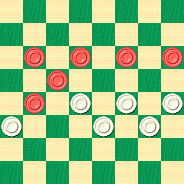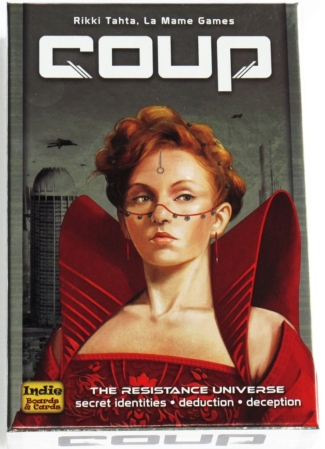Cowan's Coup Revisited
Just over five years ago, we published a column on Cowan's Coup based on analysis by Willie Ryan. This week in our Checker School entry, we'll revisit the position and gain the benefit of Ben Boland's viewpoint, as expressed in his classic Famous Positions in the Game of Checkers.

BLACK
White to Play and Draw
W:W24,23,21,20,19,18:B17,14,12,11,10,9.
No matter what move White makes, he's going to lose two men at once. Yet we're asked to find a move that draws.
Is this a coup that you can pull off? Please do try; after all, this is a non-violent coup. But if the solution eludes you, or you'd just like more insight, you can click on Read More to see one way to do it along with numerous sample games and an explanatory note or two.![]()
Solution
Numbered notes are by the editor, using the KingsRow computer engine. All other material is from Mr. Boland's book.
19-16---1, 12-28-A, 23-19, 14-23, 21-7---2, 28-32, 7-3, 32-27, 3-8, 9-13, 8-15---3. Drawn.
Game: 11-15, 23-18, 8-11, 27-23, 4-8, 23-19, 10-14, 19-10, 14-23, 26-19, 7-14, 22-17---4, 6-10, 30-26, 11-15, 17-13, 8-11, 13-6, 2-9, 26-22, 3-8, 32-27, 11-16, 27-23, 16-20, 22-18, 15-22, 25-18, 20-27, 31-24, 9-13, 18-9, 5-14, 29-25, 1-6, 25-22, 8-11, 24-20, 6-9, 28-24, 11-15, 20-16---5. Forms above position, colors reversed. D. Gourlay.
Game: 9-14, 22-18, 5-9, 24-19, 11-15, 18-11, 8-24, 28-19, 4-8, 25-22, 8-11, 22-18, 11-16, 29-25, 7-11, 25-22, 10-15, 19-10, 6—15, 27-24, 16-20, 23-19, 20-27, 19-10, 14-23, 26-19, 9—13, 31-24, 2-7, 30-26, 7-14, 26-23, 3-7, 24—20, 7-10, 32-28, 1-5, 28-24, 5-9, 22-18, 13-17. Chas. Hefter.
Game: 9-13, 24-19, 11-15, 28-24, 6-9, 22-18, 15—22, 25-18, 9-14, 18-9, 5-14, 29-25, 8-11, 24-20, 11-15, 19-16, 12-19, 23-16, 15-18, 26-22, 1-6, 22-15, 10-19, 25-22, 4-8, 22-18, 14-23, 27-18, 6-9, 30—26, 8-11, 32-28, 2-6, 16-12, 19-23, 26-19, 6-10, 12-8, 3-12, 31-27, 10-14, 27-23, 7-10, 28-24, 13-17. A. J. Heffner.
Game: 11-15, 24-20, 8-11, 28-24, 3-8, 22-18, 15-22, 25-18, 9-13, 26-22, 5-9, 29-25, 1-5, 32-28, 13-17, 21-14, 10-26, 31-22, 6-10, 30-26, 9-13, 18-15, 10-19, 24-15, 11-18, 22-15, 2-6, 26-22, 7-10, 23-19, 5-9, 27-23, 10-14, 25-21, 8-11, 15-8, 4-11, 22-18, 6-10, 28-24, 13-17. F. Tescheleit.
A---12-26, 24-19, 14-23, 21-7, 26-31, 7-3, 9-13, 3-8. Drawn.
1---Did you see this amazing move? Everything else of course loses.
2---Careful; 21-5 loses here. But White will still be a man down.
3---If you saw this through all the way to the finish, you're quite a skilled player.
4---Not the best move; 24-20 is better but White gives the advantage back at once by playing 6-10 instead of 14-18.
5---What's so interesting here is that the Black moves have not been objectively bad, yet he's now faced with the need to pull off a "coup" to draw. This points out the enormous difference between doing analysis and playing over the board.
M. Cowan first published the position as No. 860 in the Glasgow Weekly Herald, July 15, 1882. He however did not give any game leading to the position: Then in the December 9th Issue of the Glasgow Weekly Herald, came D. Gourlay.
Cowan's setting may be found as No. 850 in Gould’s Problem Book, while Gourlay's which is a few moves earlier is No. 531. F. Tescheleit in his Master Play of the Draught Board, Part 2, suggests the position be known as “Cowan-Gourlay," instead of “Cowan” position.
You can email the Webmaster with comments on this article.
